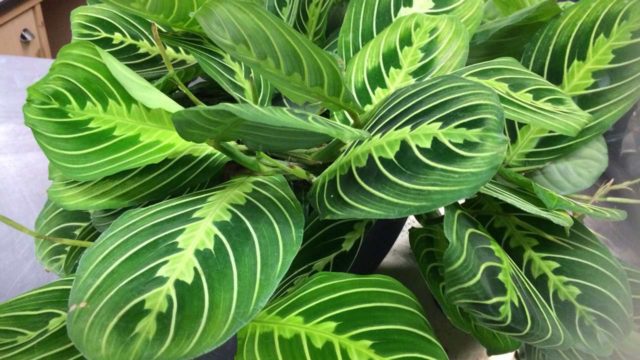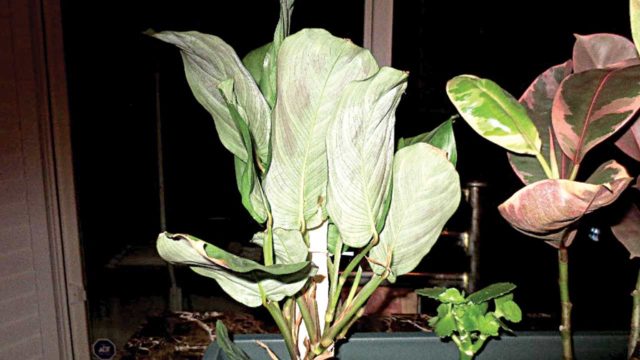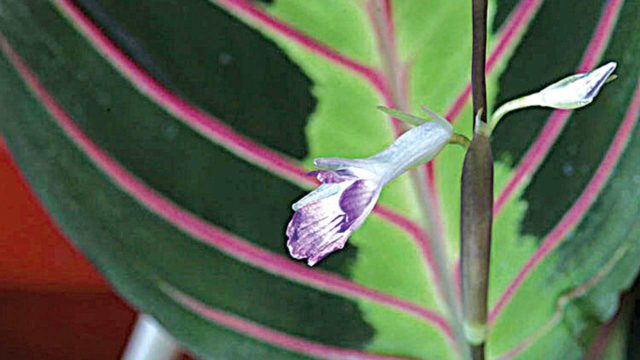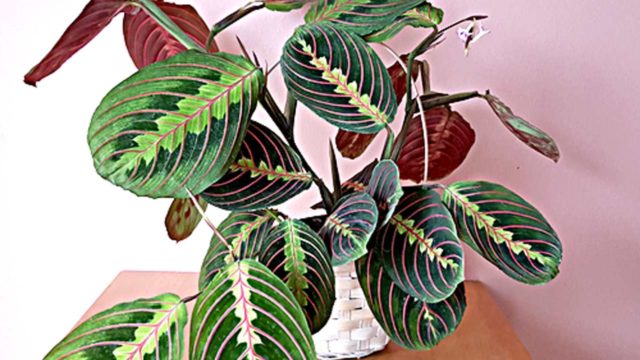Tropical prayer plants are some of the most beautiful house plants you can find. The oval-shaped, beautifully patterned foliage of prayer plant has earned it a favored spot among houseplants. Indoor gardeners love these plants, sometimes too much. Whether you are just starting out with houseplants or an expert grower, the prayer plant is an excellent choice. Given the right light, moisture and temprature they will thrive.
Prayer plant, scientific name Maranta leuconeura are a species of perennial flowering plants in the botanical family Marantaceae, which are native to the tropical regions of South America, West Indies, Asia and Africa. This tropical plant boast beautiful decorative broad oval leaves with variegated shades of green, but here’s what’s really special about them. The prayer plants (also called praying hands, Obedience Plant) gets its name for its unique habit of raising the leaves to an upright position at night time like the way children put their hands together to pray. The leaves fold like hands during prayer. They open again with the morning light, sometimes with a faint rustle. Prayer plants require specific care, but when they receive it, they are happy and are showy additions to your plant collection. They are colourful perennials, ideals for decorating interiors. They are great potted and in hanging baskets as they spread low and wide. In tropical and subtropical climate, they grow outdoors in shady spots with filtered or indirect sunlight, and as indoor plants also for cooler climate.
Types of Prayer Plants
There are around 40-50 different species of prayer plants, but the most popular by far is Maranta Leuconeura. There are multiple varieties of prayer plants, differentiated by their leaf markings. Red prayer plants have rich red veins running through them, and are one of the most striking examples. Lemon/or lemon limes look similar to the red but with light green/ white veins instead. The black variety has a more olive green base with silver markings and veins, along with purple spots. Both Green and Kim prayer plants have less prominent veins and are noted for their large spots- either green (former) or deep, deep purple (the latter). Here are a few varieties of Maranta Leuconeura
Maranta Leuconeura var. leuconeura.
The black variety of this plant has a bluish silver on the leaves, with purple spots and a deep green leaf
Maranta Leuconeura kim
Is a purple spotted variety of prayer plant. Aside from the purple spots, the leaves have a creamy-white streak for extra flair.
Maranta Leuconeura Marisela var
The leaves are a lighter shade of green and the markings an even lighter green- almost a cream-green colour.
Maranta Leuconeura var. erythroneura
Have dark green leaves with purple- patterned markings. The veins are a deep blood-red colour.
Flowers
Prayer plants will flower small purple, or white or pink blooms. However it is the foliage that is the main attraction.
Prayer Plant Care
Maranta care is slightly more complicated than easier houseplant like Pothos or Dracaena once you get the hang of it, though you should have no problem, giving them what they need to thrive. These are tropical understony plants, they like bright filtered light, humidity and moisture.
Watering
Prayer plants water preference echoes their tropical native conditions. They don’t like to be dry, they like to be kept evenly moist and just barely damp to touch. Never let it get soggy. Prayer plant also appreciates being watered using water that is at least at room temperature or with warm water. Use rainwater rather than tap water which can cause excessive build up of salts.
Humidity
Prayer plants needs high humidity in order to thrive. Household humidity is likely too low for them. To give your prayer plant the microclimate it likes, group it together with other plants to help create mere humid conditions, misting it daily with warm water. Placing a bowl of water near the plant or placing it on a dish filled with pebbles and water (while making sure that the plants isn’t actually resting in the water).Prayer plants fine and shallow roots are prone to root rot. Make sue that soil is well-draining and that your pot has a drainage hole. Because of their shallow root system, it is best to plant prayer in shallow pots that have good drainage holes. To prevent compact soil , repot yearly, keeping soil loose.
Soil
A general- purpose house plant potting mixture can be used that includes peat moss, sand and loam, that is well draining. If you are using soil that doesn’t drain well, add perlite or coarse sand to the mixture. To mix your own soil for prayer plants use:
1 Part perlite or coarse sand
1Part garden soil
1Part peat or humus
1 pinch of lime dust . To improve drainage, add rocks or gravel to the bottom of your pot and be sure that the pot has a drainage hole.
Light
Direct sunlight can scorch the leaves of prayer plant and can quickly kill the plant. It prefers bright but indirect sunlight and it’s generally tolerant of lower light locations. On the other hand, without enough light, your prayer plants leaves won’t open all the way in the morning, so watch out for this signal as well.
Fertilizer
Prayer plants are acid-loving plants. Avoid using fertilizers with phosphate in them to stop salt build-up. Use a water- soluble fertilizer of half the strength recommended every two weeks. Your prayer plant will also enjoy left-over teas as well.
Repotting
You shouldn’t need repotting too often. However, when it becomes root bound in its pot, its growth will be stunted. Use ordinary potting soil. Choose a pot that is 1-2 inches wider than the existing pot. Simply remove it from the current pot and put it in the new pot with a bit of extra soil mix and water well.
Pruning
Prune your plants in order to keep their pleasant bushy appearance. Cut back older leaves. Use a sterilized pair of sharp garden sissors or shears and clip the stems right above a leaf node. The plants will respond by sending up new shoots directly below the cut area, making for a bushier appearance.
Propagation
Propagating prayer plant is suprisingly easy, giving how finicky they can be to care for! Take cuttings just below the nodes closest to the bottom of the stem. Cuttings can be placed in a mixture of moist peat and perlite and covered with plastic to retain moisture levels. You may want to poke a few holes in the plastic to allow for adequate ventilation as well. Place the cuttings in a sunny location. If a piece of prayer plant has broken off, dip the broken end in rooting hormone and place it in clean or distilled water. Change the water every other day. Wait until the roots are about an inch long before taking it out to place in the soil. Keep in mind with prayer plant propagation there’s need to have at least a small portion of leaves and stem for the piece to take root. Alternatively, the piece can be rooted directly in soil as with cuttings.
Prayer plants are non-toxic to dogs and cats.
Learning how to grow a prayer plant is easy and it rewards well worth any issues you may come across along the way.
[ad unit=2]










